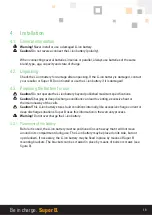
3
Be in charge.
Super B.
Table of content
1. Safety guidelines and measures
5
1.1. General
5
1.2. Disposal
5
2. Introduction
6
2.1.
Product description
6
2.2.
Intended use
6
2.3.
Glossary of Terminology
6
2.4.
Used symbols
6
3. Product specifications
7
3.1.
Product features
7
3.2.
Technical specifications
7
3.2.1. Electrical specifications
7
3.2.2. Mechanical specifications
7
3.2.3. Charge & discharge specifications
8
3.2.4. Temperature specifications
8
3.2.5. Compliance specifications
8
3.2.6. General product specifications
8
3.3.
Environmental conditions
9
3.4.
Scope of delivery
9
3.5.
Connections, indicators and battery controls
10
3.5.1. Con 1 (Output for bistable relay)
10
3.5.2. Con 2 (I/O connection 7)
10
3.5.3. Con 3 (CANopen; 5-pin “micro” style connector)
11
3.6.
Peripheral equipment
11
3.6.1. Obligatory
11
3.6.2. Optional Components
12
4. Installation
13
4.1.
General information
13
4.2. Unpacking
13
4.3.
Preparing the battery for use
13
4.3.1. Placement of the battery
13
4.3.2. Placement and removal of a fuse
14
4.4.
Connection wires
15
4.5.
Installing the mandatory external disconnect device
15
4.5.1. Connecting a bistable relay to the Li-ion battery
15
4.5.2. Connecting a normal relay as an external disconnect device
16
4.5.3. Using the SB BIB (Battery Interface Box)
17
4.5.4. Using the SB BCI-C1 (Battery Communication Interface) with a normal relay
17
4.6.
Connecting the Li-ion battery to the load/charger
18




































